Warmth meets drama when black partners with beige in a living room, balancing cozy serenity with sculptural impact. Designers highlight how the comeback of richer beiges in 2025 offers the perfect neutral backdrop for inky statements, allowing homeowners to experiment without overwhelming the senses. At the same time, the enduring appeal of black accents—whether through paint, metals, or textiles—anchors space and draws the eye, creating focal points that feel both modern and timeless. By weaving these hues through furniture, finishes, and decor, you can craft a space that feels layered, sophisticated, and uniquely yours, inviting daily relaxation and confident entertaining.
1. Layer Neutral Foundations First
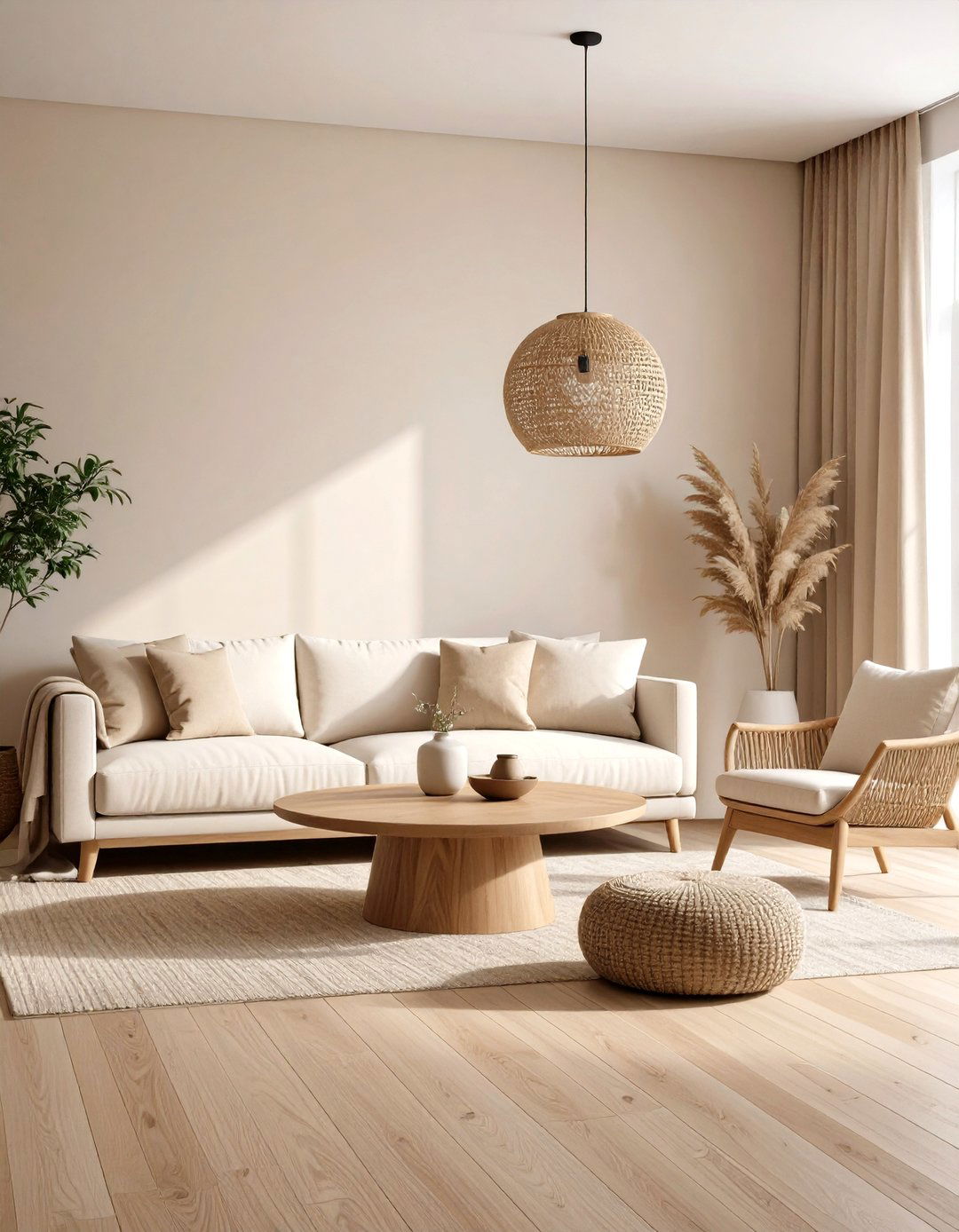
A layered neutral base lets black features sing without stealing comfort from the living room. Begin with walls painted a warm, creamy beige that reflects natural light and sets a soothing stage; trend analysts note these to be the most requested paint tones of 2025 for their ability to warm large open spaces. Flow the same beige onto larger upholstery—sofas, armchairs, and ottomans—to maintain visual continuity. By repeating the color on foundational pieces, you allow future black elements to appear intentional rather than random, establishing harmony from the outset. Finish the groundwork with pale wood floors or a light jute rug, reinforcing an inviting atmosphere.
2. Define a Striking Black Accent Wall

Unlike an all-dark cave, a single black accent wall injects dramatic depth without sacrificing brightness in a living room. Paint the wall behind the sofa or television in a rich matte black so it recedes visually, making the room appear longer while showcasing lighter furnishings in front. Design experts suggest treating trim in the same finish to create a seamless envelope and avoid busy edges. Keep adjacent walls beige so light can bounce around; the contrast energizes the palette and frames artwork beautifully. To soften the shift, mirror the black tone in slim picture frames or a nearby lamp base, weaving continuity through subtle repetition.
3. Ground the Living Room with Beige Seating

To ground the scheme, invest in generously cushioned beige seating that invites lingering conversation in the living room. Opt for fabrics like performance linen or textured chenille that offer tactile richness yet visually fade into the background, letting accessories claim the spotlight. Recent living room trend forecasts emphasize how classic, comfortable silhouettes upholstered in neutral tones make spaces feel curated rather than staged and transition gracefully through seasons. Layer darker accent pillows—charcoal, espresso, or jet black—against the beige so every sit feels like a styled vignette. Because beige reflects surrounding hues, the black details appear sharper, providing instant, low-effort sophistication.
4. Frame the Scene with Slim Black Metal

Consider sleek black metal as the living room’s jewelry, framing views without adding weight. Coffee tables with slender powder-coated legs, matte-black curtain rods, and lightweight iron side chairs introduce graphic lines that echo the accent wall yet leave plenty of negative space. Decor specialists point out that a strategic touch of black grounds otherwise airy neutrals, helping the eye settle and giving beige elements a polished outline. Because metal reflects light subtly, it keeps the ensemble from feeling heavy. Repeat the finish in picture frames or cabinet hardware so each reference feels purposeful and the overall look reads collected.
5. Introduce Organic Textures for Depth
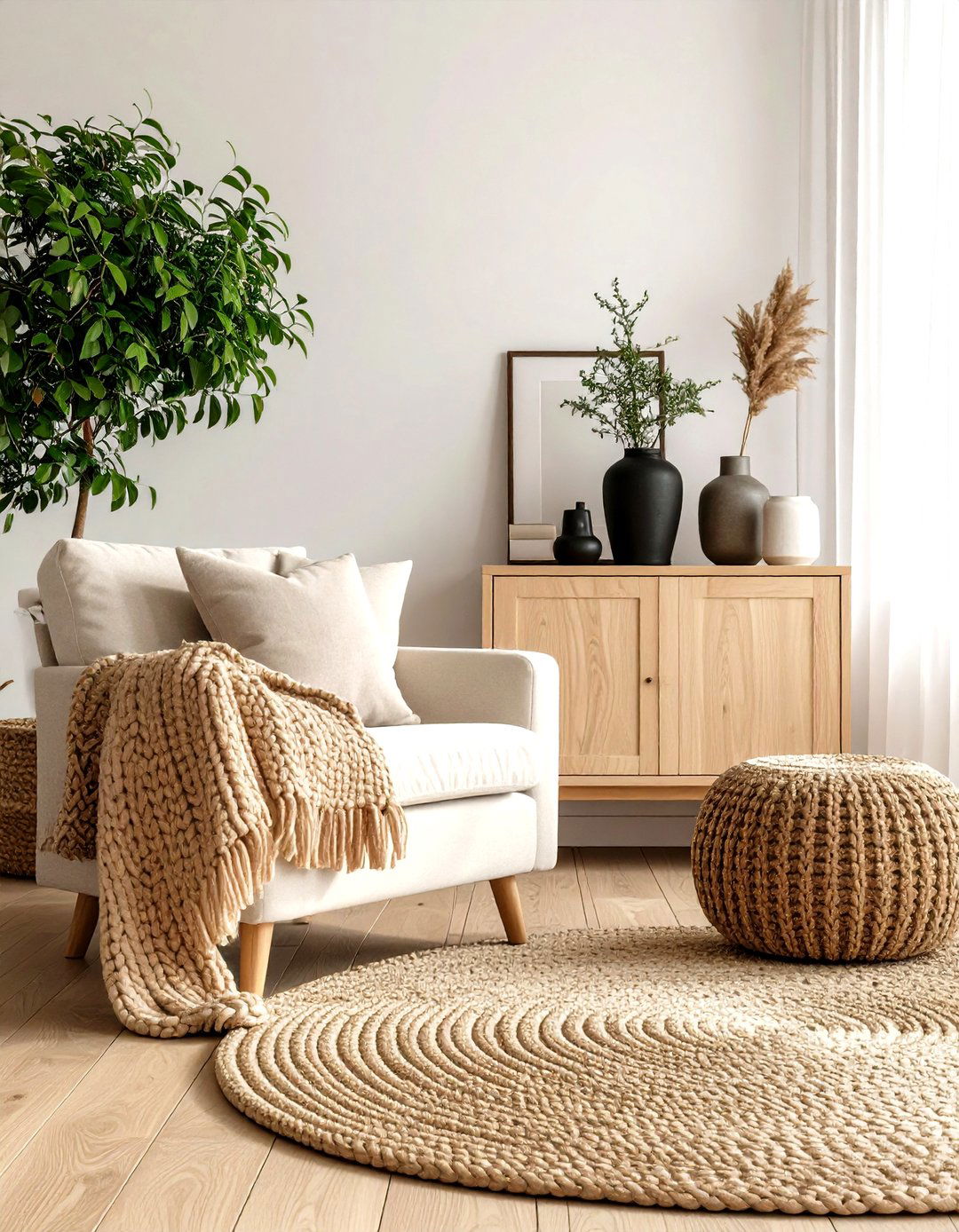
Bringing woven, weathered, and natural materials into a black-and-beige living room adds whispered layers of depth. Think of chunky knit throws, rattan planters, or bleached oak sideboards that share beige undertones while contrasting with crisp black contours. Color-palette research urges homeowners to “dust in dark” but keep the scene lively with contrasting textures rather than additional hues. Earth-toned ceramics and clay accents predicted to dominate 2025 interiors amplify the look by offering subtle tonal shifts inside the same neutral family. The result feels curated, tactile, and irresistibly cozy without diluting the clean two-color statement.
6. Sparkle with Subtle Metallics
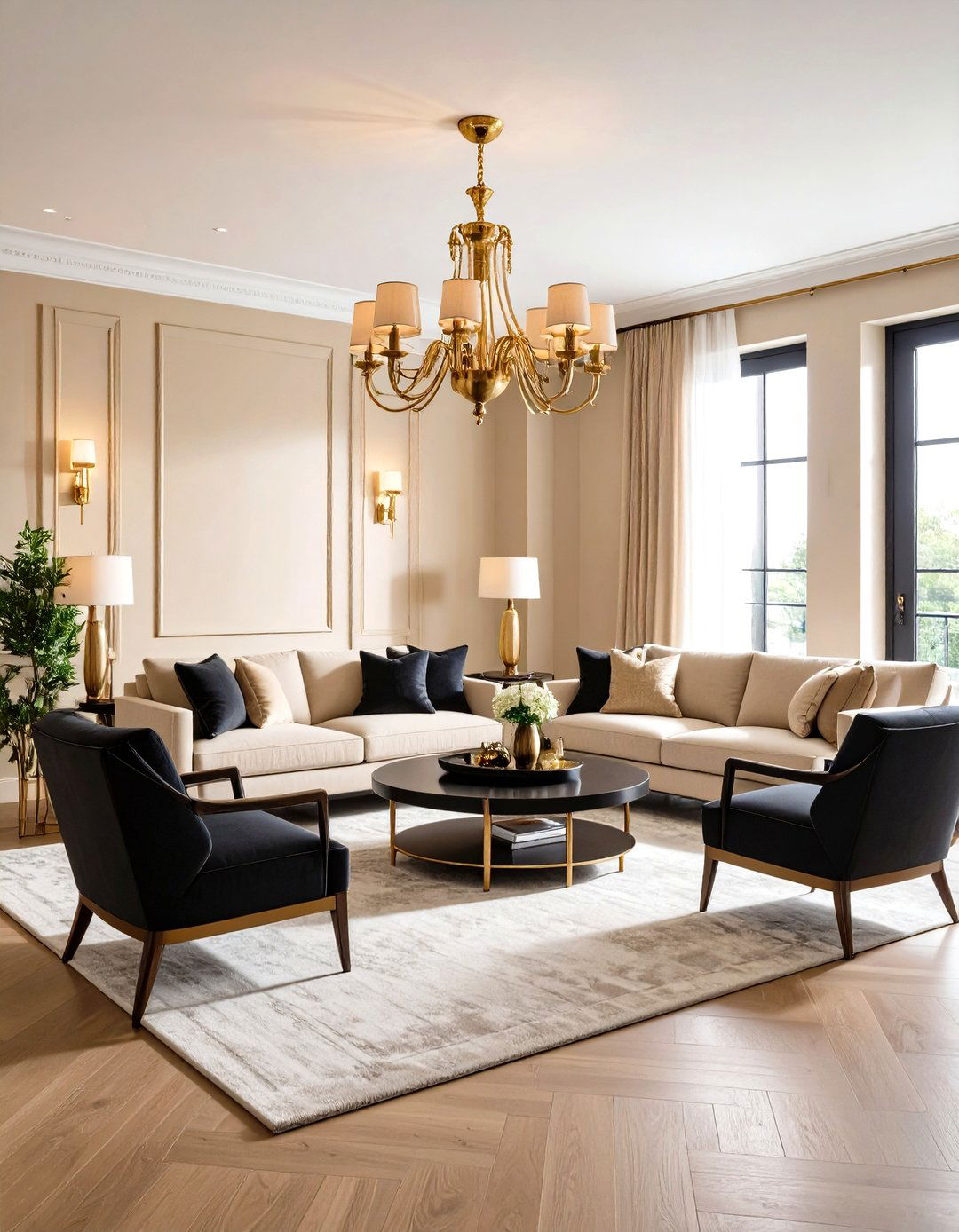
As a room of contrasts, the black-and-beige living room benefits from a whisper of metal that catches the eye without detracting from the palette. Swap common chrome for brushed brass or antique gold, metals that share warm undertones with beige while popping against black backgrounds. Design pros cite brass sconces or a geometric chandelier as favorite ways to introduce light play and instant elegance. Because metallics reflect surrounding colors, they echo beige during the day and deepen beside black at night, adapting naturally to different moods. Keep metallic touches restrained, focusing on two or three key pieces for coherence.
7. Soften Light through Beige Textiles
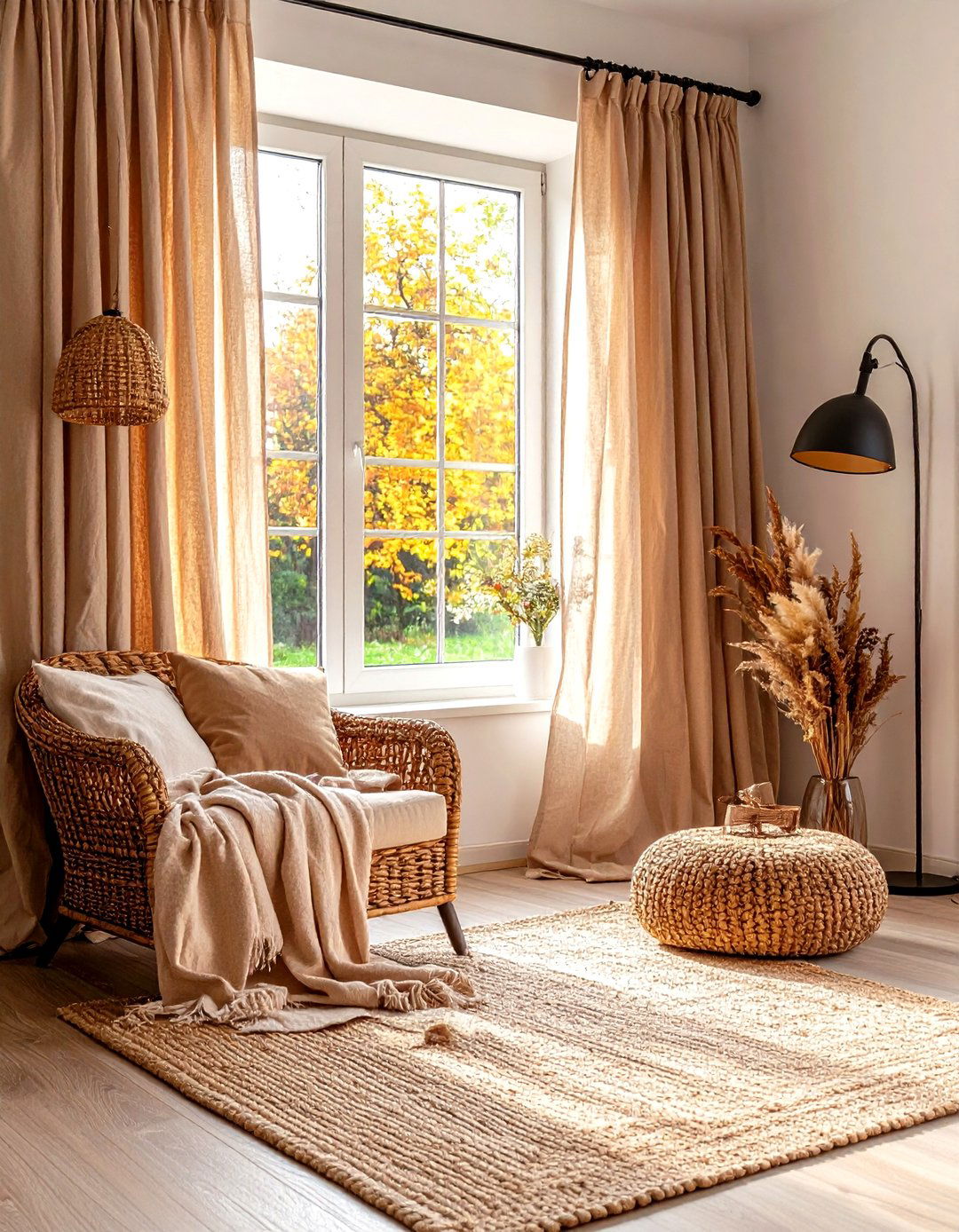
To temper the boldness of black, drape the living room’s windows with floor-grazing beige curtains or Roman shades. Warm neutrals filter daylight into a gentle glow that flatters skin tones and furniture alike, a technique color consultants recommend when balancing strong darks in compact spaces. Choose fabrics with a slight slub—linen blends or basket-weave cotton—to increase visual interest without adding extra colors. When drawn at night, the beige panels act as a calm backdrop for black metallic lamp bases or art frames, further reinforcing the organized palette. Pair them with coordinating beige throw pillows to echo softness across the room.
8. Build Character with Black Built-Ins
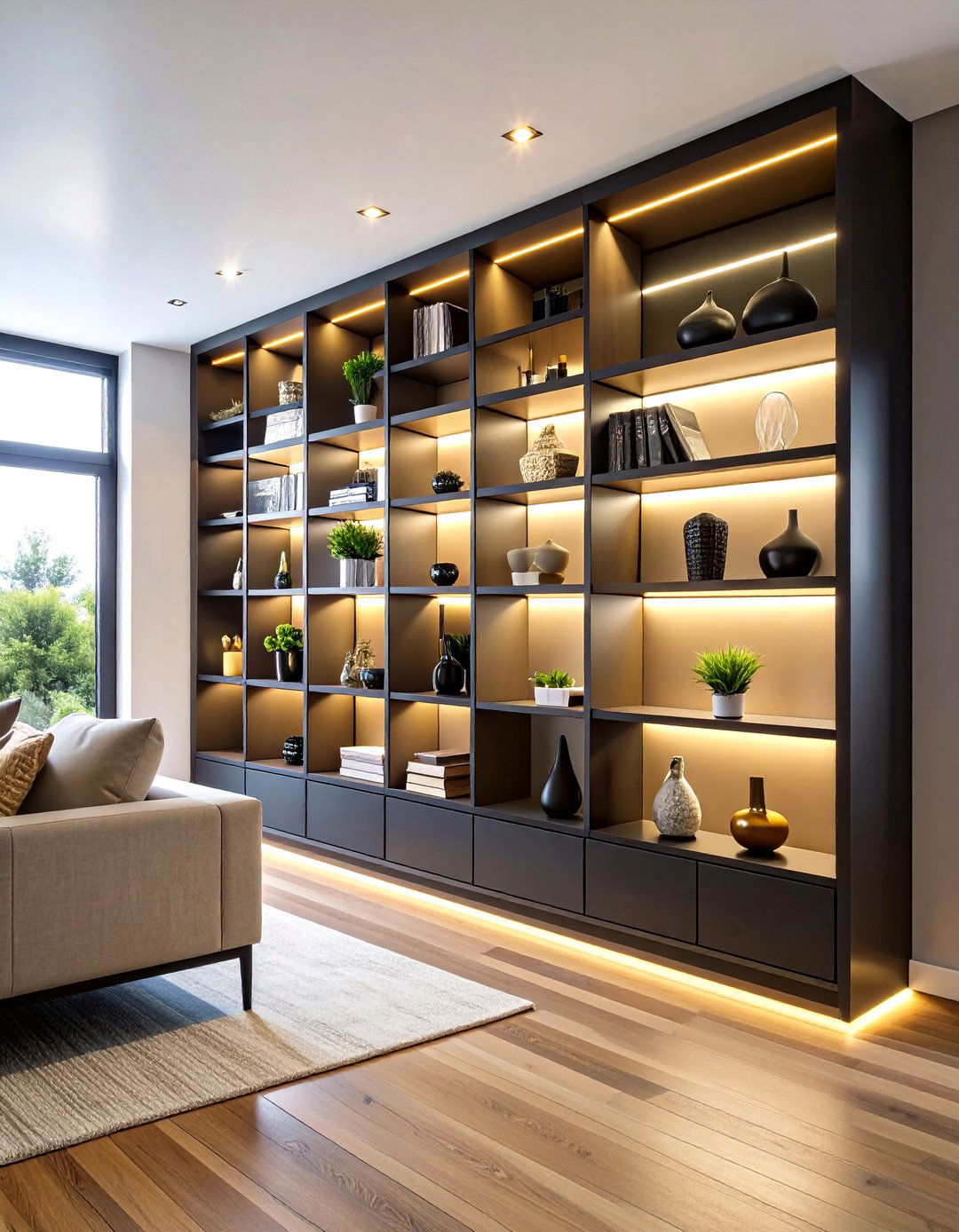
One transformative move is installing built-in shelving or cabinetry in a satin black finish, instantly adding architectural gravitas to the living room. Experts observing the return of separate, thoughtfully designed living spaces note that permanent black millwork creates a gallery-like setting for books, ceramics, and sentimental objects. Paint the shelf interiors beige or line them with natural cane to lighten the look and showcase displayed pieces. The interplay of recesses and shadows prevents the large structure from feeling monolithic, while integrated lighting can highlight art and reinforce a warm ambiance. This high-contrast statement looks both custom and timeless.
9. Anchor with a Patterned Rug
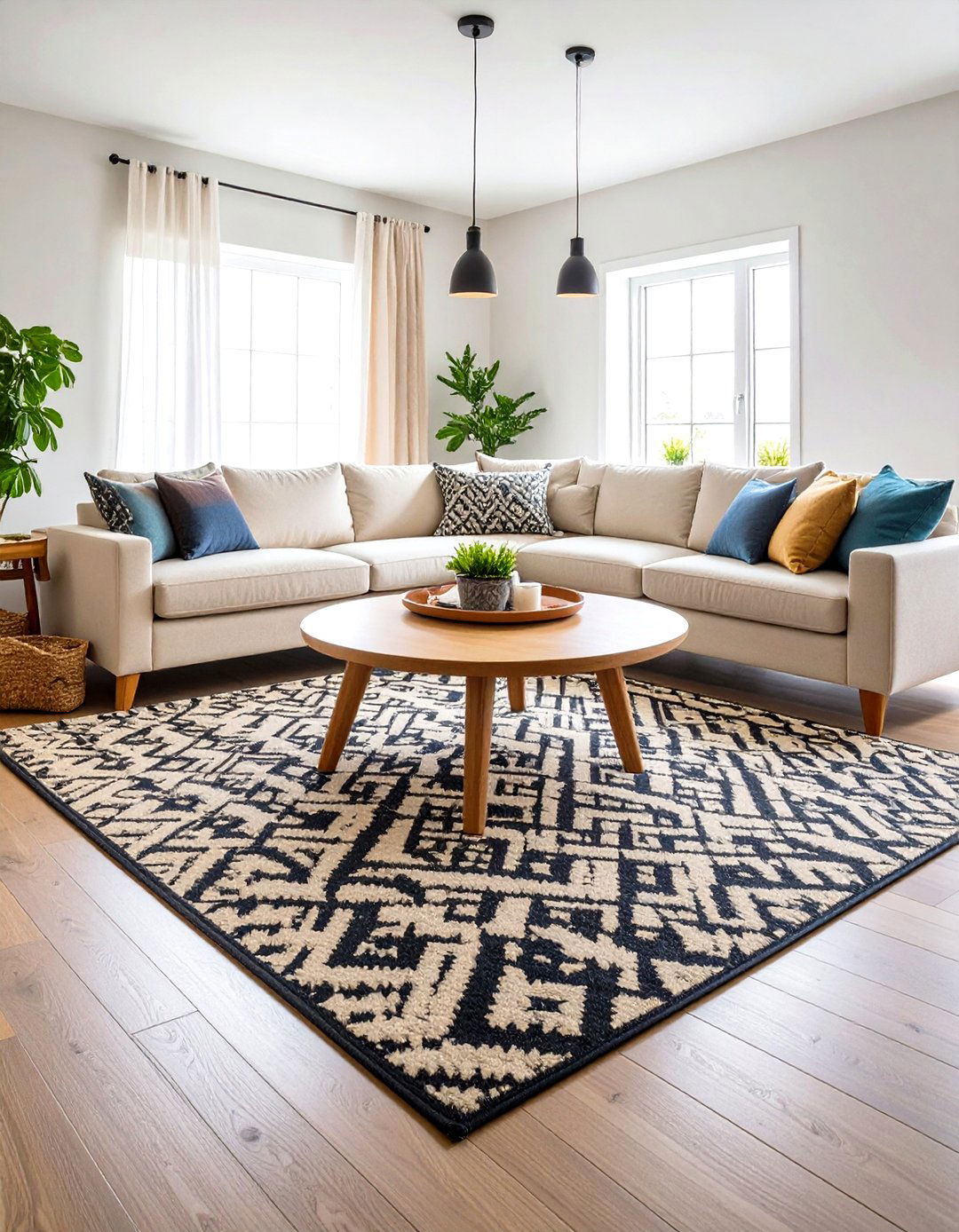
Looking for an instant focal point? Roll out a rug that interweaves black and beige motifs—think bold geometric trellis or subtle Persian floral—to anchor the living room’s seating area. Stylists remind us that pattern brings vitality to neutral schemes, preventing beige from appearing flat and ensuring black accents feel integrated rather than pasted on. Select a size large enough that front furniture legs rest upon it; this unifies scattered pieces into one cohesive zone. A medium pile adds comfort underfoot while still allowing coffee tables to remain stable. To finish, echo the rug’s pattern scale in throw cushions for rhythm.
10. Mix Prints in the Same Palette
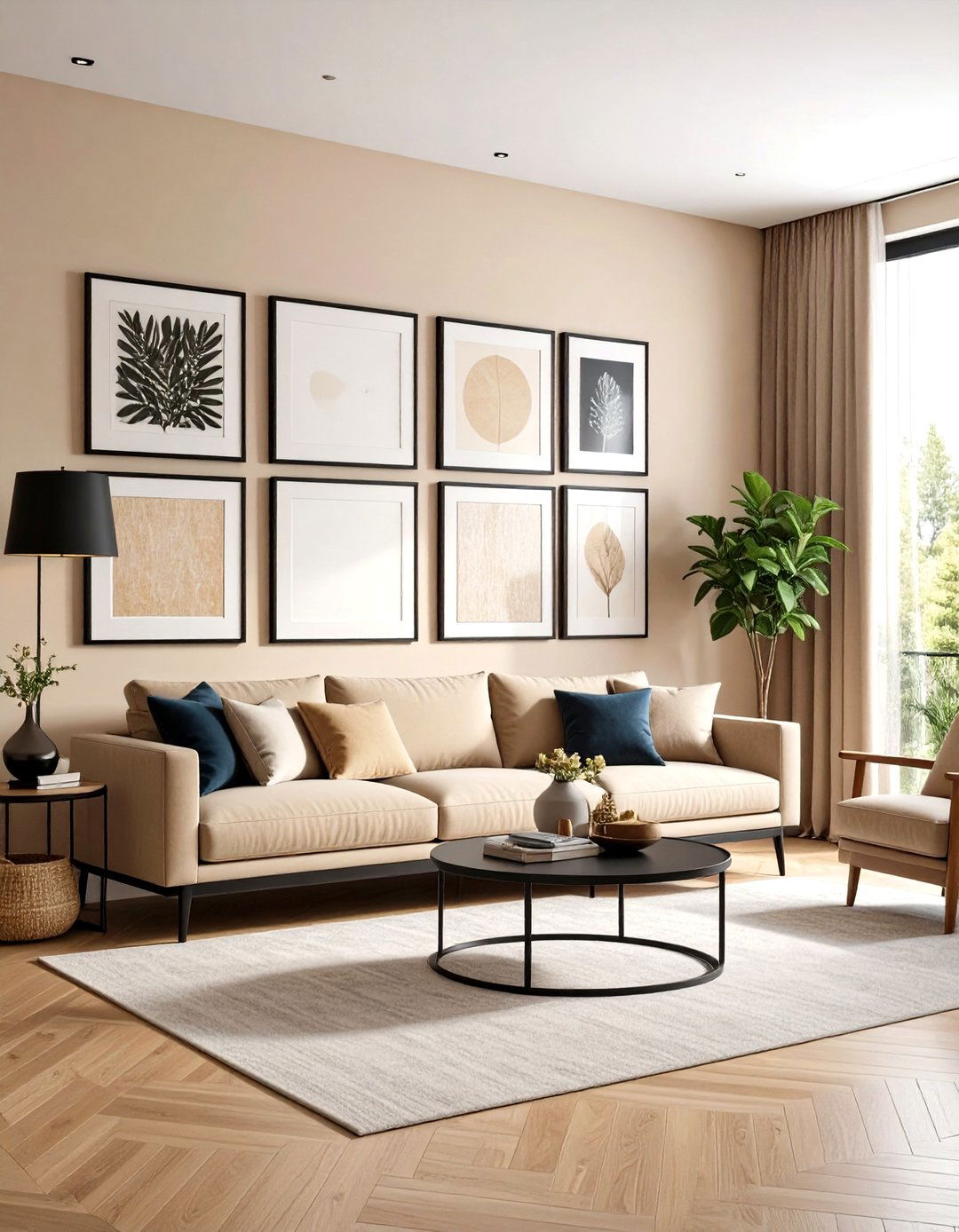
What could feel more curated than a medley of prints—stripes, checks, botanicals—executed solely in black, beige, and cream? Pattern layering is a stylist trick for injecting personality into neutral living rooms without introducing extra colors. Visual guides showcasing beige-and-black rooms highlight how varying print scale keeps the eye moving and distracts from everyday clutter. Confine large motifs to drapes or an ottoman while reserving smaller designs for pillows or lampshades to avoid chaos. A unifying color palette ensures the result feels intentional, playful, and unmistakably tied to the black-and-beige story unfolding throughout the space.
11. Curate a Monochrome Gallery Wall

Consider converting a bare beige wall into an art moment by arranging black-framed prints in a structured grid. Design insiders suggest limiting mat colors to creamy off-white so artwork stands out while harmonizing with surrounding beige paint. Black frames link instantly with other dark accents in the living room, delivering cohesion without extra furniture. Keep spacing equal—about two inches—to maintain a clean architectural feel. Mix photography, sketches, and even fabric swatches to add texture. The monochrome approach means you can rotate pieces over time without disrupting the color scheme, keeping the display fresh and personal.
12. Elevate with Matte Black Lighting
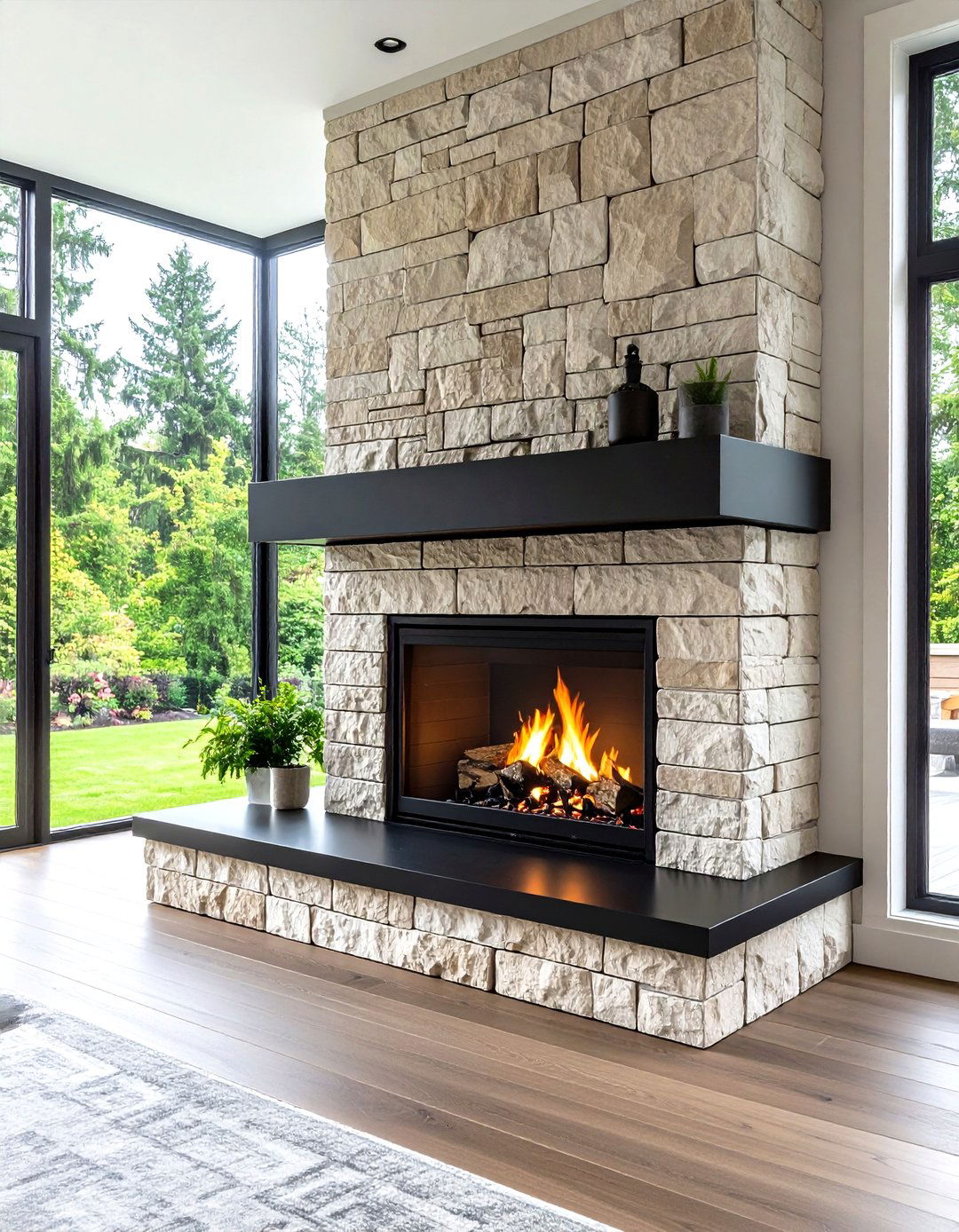
Lighting functions as both utility and sculpture, so choose matte black fixtures that command attention against beige ceilings. Popular advice from design trend spotters highlights how a black chandelier or sconce silhouette introduces crisp outlines that echo other dark accents while distributing a soft ambient glow. Opt for warm-white bulbs (2700–3000 K) so the beige walls stay cozy rather than stark. If ceilings are high, a multi-arm black fixture visually lowers the room for intimacy; in smaller spaces, slim black reading lamps flanking a sofa add symmetry without clutter. Ensure metal finishes coordinate with any brass details to maintain harmony.
13. Warm Up Around a Stone Fireplace

A fireplace clad in sandy limestone or honed travertine offers tactile warmth and visual continuity with beige seating, while a black steel hearth or insert supplies bold contrast. Designers forecasting the rise of earthy, organic materials in 2025 see stone fireplaces as a perfect stage where neutral palettes meet elemental texture. Keep the mantel spare—perhaps a simple vase or black framed mirror—to let materials shine. If you lack a built-in fireplace, a freestanding bioethanol stove in matte black can achieve a similar cozy focal point without major renovation, preserving the two-tone balance effortlessly.
14. Showcase Sculptural Black Details
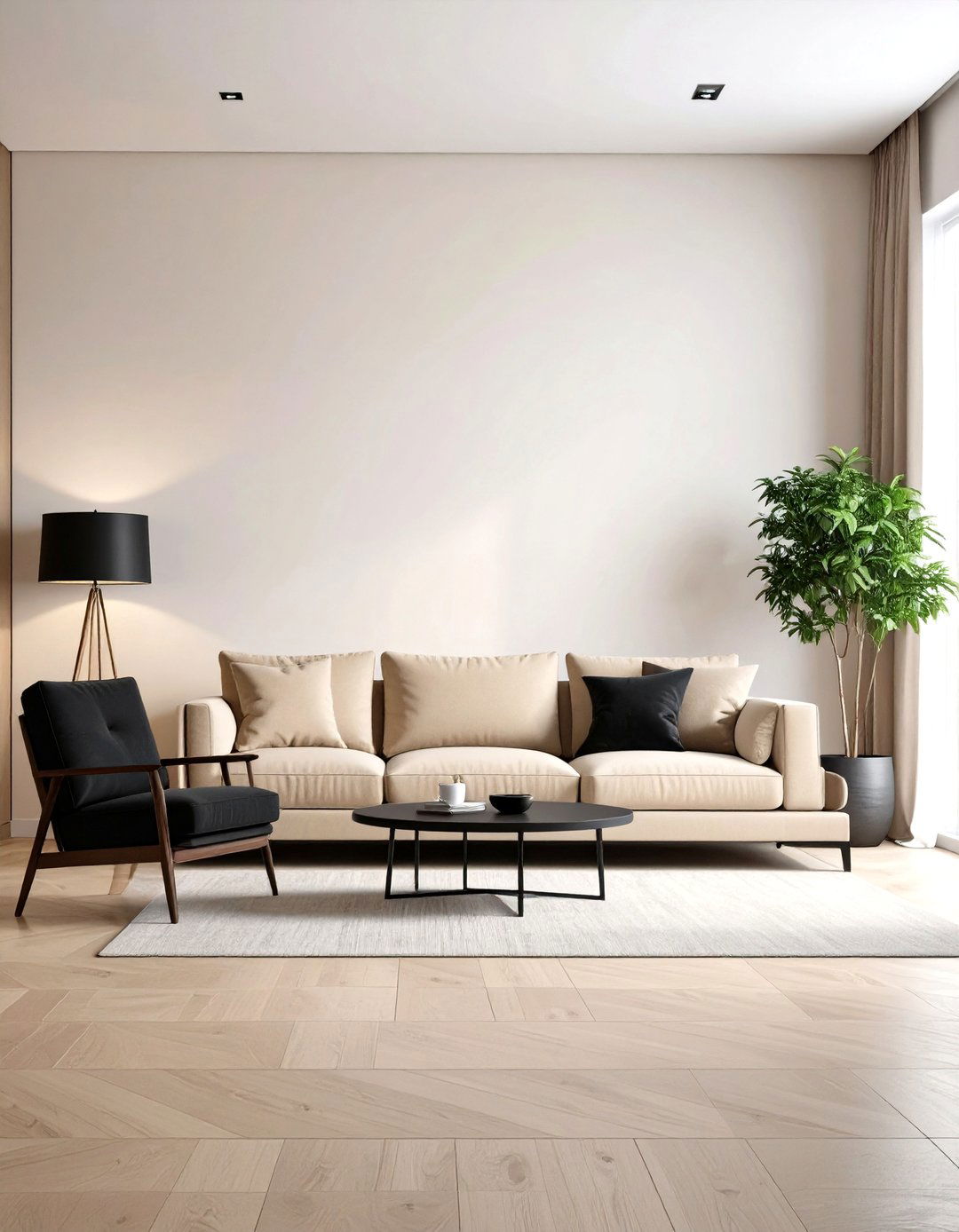
Looking for artful punctuation? Add sculptural black details—think angular side tables, abstract ceramic vases, or wrought-iron candleholders—to punctuate zones throughout the living room. Photo collections of black-and-beige spaces illustrate how these small, dramatic objects create visual pauses that keep the neutral field lively. Place a single statement piece on a beige console or inside an open shelf, allowing its shadow to dance across lighter surfaces. Against a beige backdrop, silhouettes become crisper, turning everyday décor into gallery-worthy art. Because the pieces are portable, you can refresh arrangements seasonally, ensuring the room never feels static.
15. Cozy Up with Layered Throws

Few accents transform a living room faster than layered throws neatly draped over seating. Choose one chunky beige knit for inviting softness and a lighter black herringbone for contrast; together they hint at warmth even when folded. Neutral room case studies consistently rank tactile accessories among top ways to boost comfort without color overload. Keep throws within reach on an adjacent rattan basket so guests feel welcome to wrap themselves on chilly evenings. Because they are inexpensive to swap, throws also offer a low-risk avenue to experiment with pattern or texture while respecting the core palette.
16. Highlight Architectural Ceilings
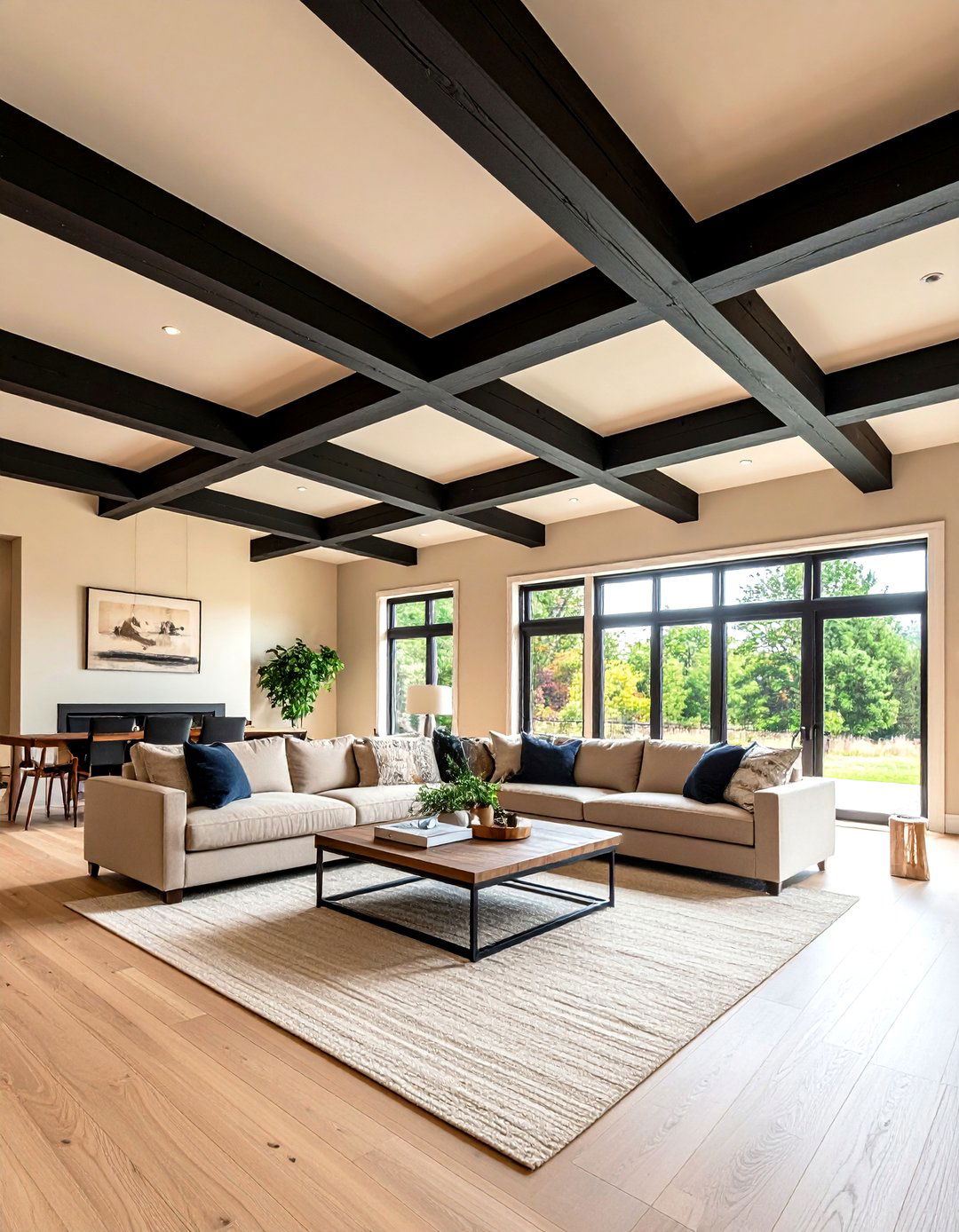
Although walls often take center stage, ceilings can magnify the drama of a black-and-beige living room. Painting beams or even the entire ceiling in soft black visually lowers lofty rooms, fostering intimacy while framing beige furnishings below. Designers frequently advocate this move when clients crave boldness that stays above eye level, preserving everyday brightness at eye height. Alternatively, leave beams in raw light wood against beige plaster to invert the contrast and showcase craftsmanship. Either approach accentuates architectural interest and draws gazes upward, making the space feel intentional from floor to sky.
17. Bring Nature Inside with Beige Botanicals
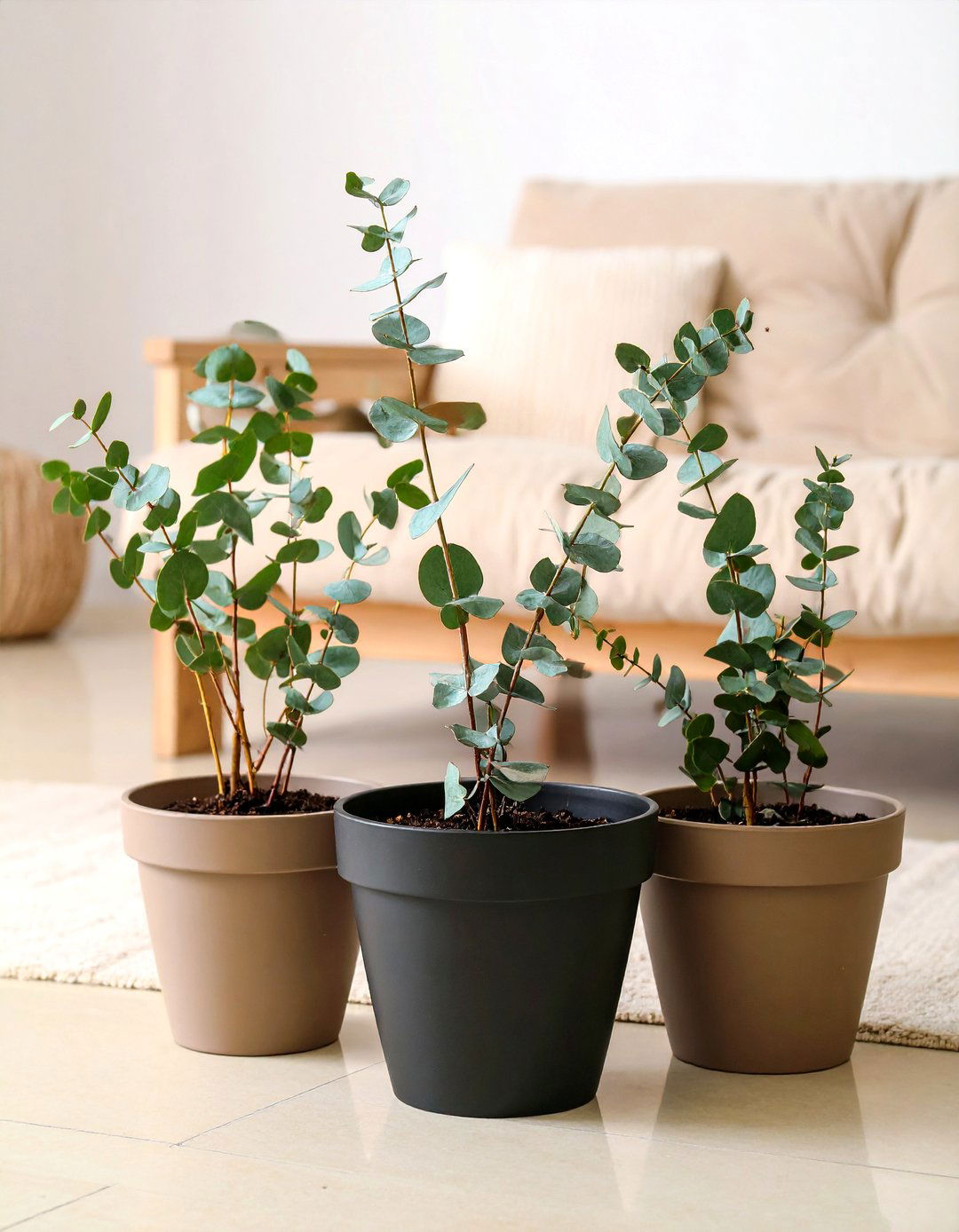
Looking to soften crisp lines? Incorporate dried pampas grass, bleached eucalyptus, or camel-colored terracotta pots filled with greenery to infuse life into the living room while staying loyal to the palette. Forecasts cite an uptick in clay and natural-fiber accents as homeowners seek grounded, earth-centered spaces. Beige botanicals add organic movement without loud color, and any fresh foliage inside black planters immediately pops against neutral walls. Rotate seasonal stems to keep arrangements dynamic; in winter, switch to branches painted matte black for a sculptural twist that still respects the scheme.
18. Make Technology Disappear
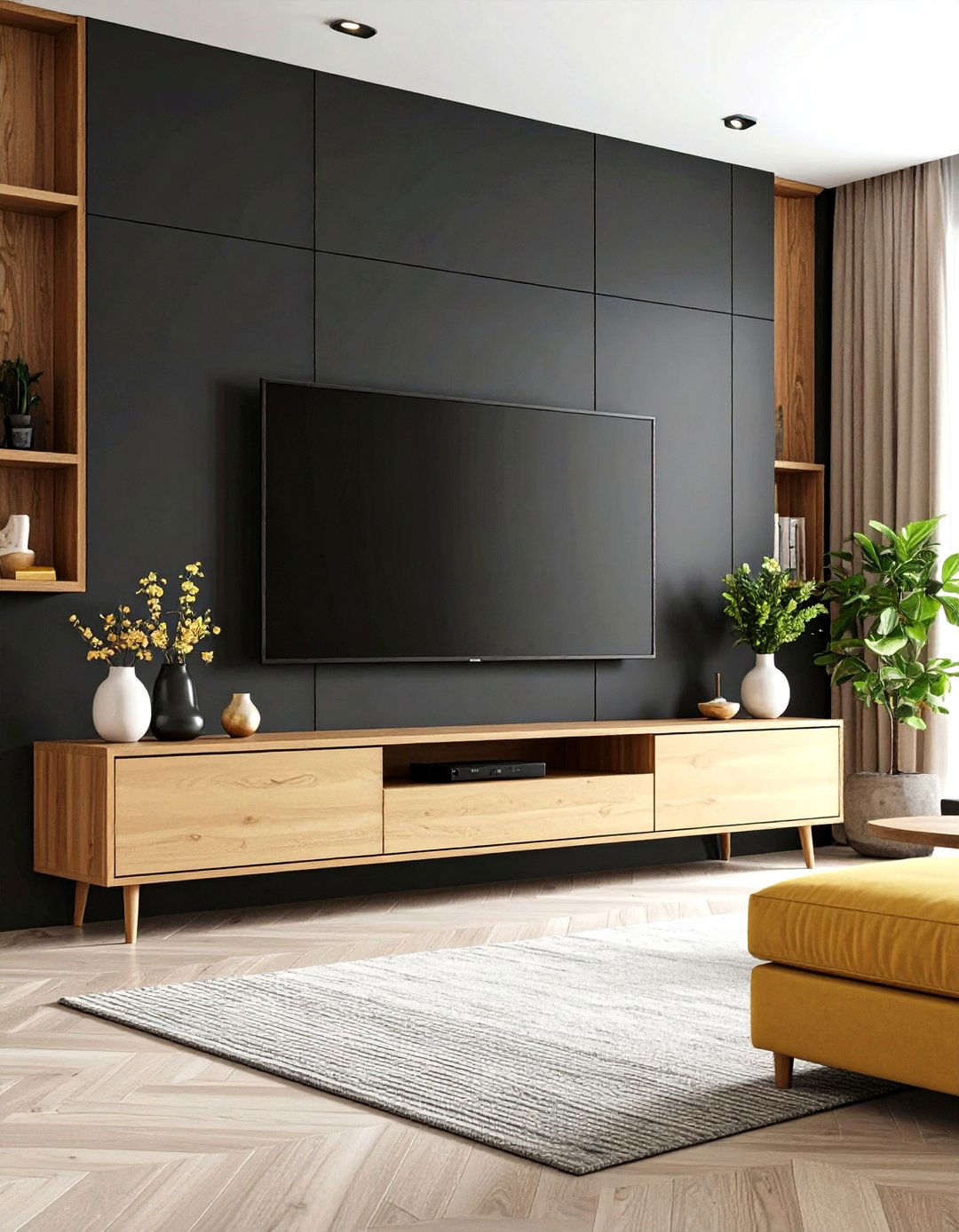
Black’s affinity with screens provides a clever way to minimize visual clutter. Mounting a television on the same black accent wall makes it virtually vanish when turned off, allowing beige seating and decor to remain the star of the living room. Contemporary design perspectives advocating separate, aesthetically pleasing gathering spaces praise this strategy for blending technology quietly into the backdrop. Hide cords within the wall or a slim conduit painted black for a seamless finish. Complement the screen with a low beige media console to store devices—its light tone ensures the dark rectangle above feels balanced, not top-heavy.
19. Embrace Minimalist Balance
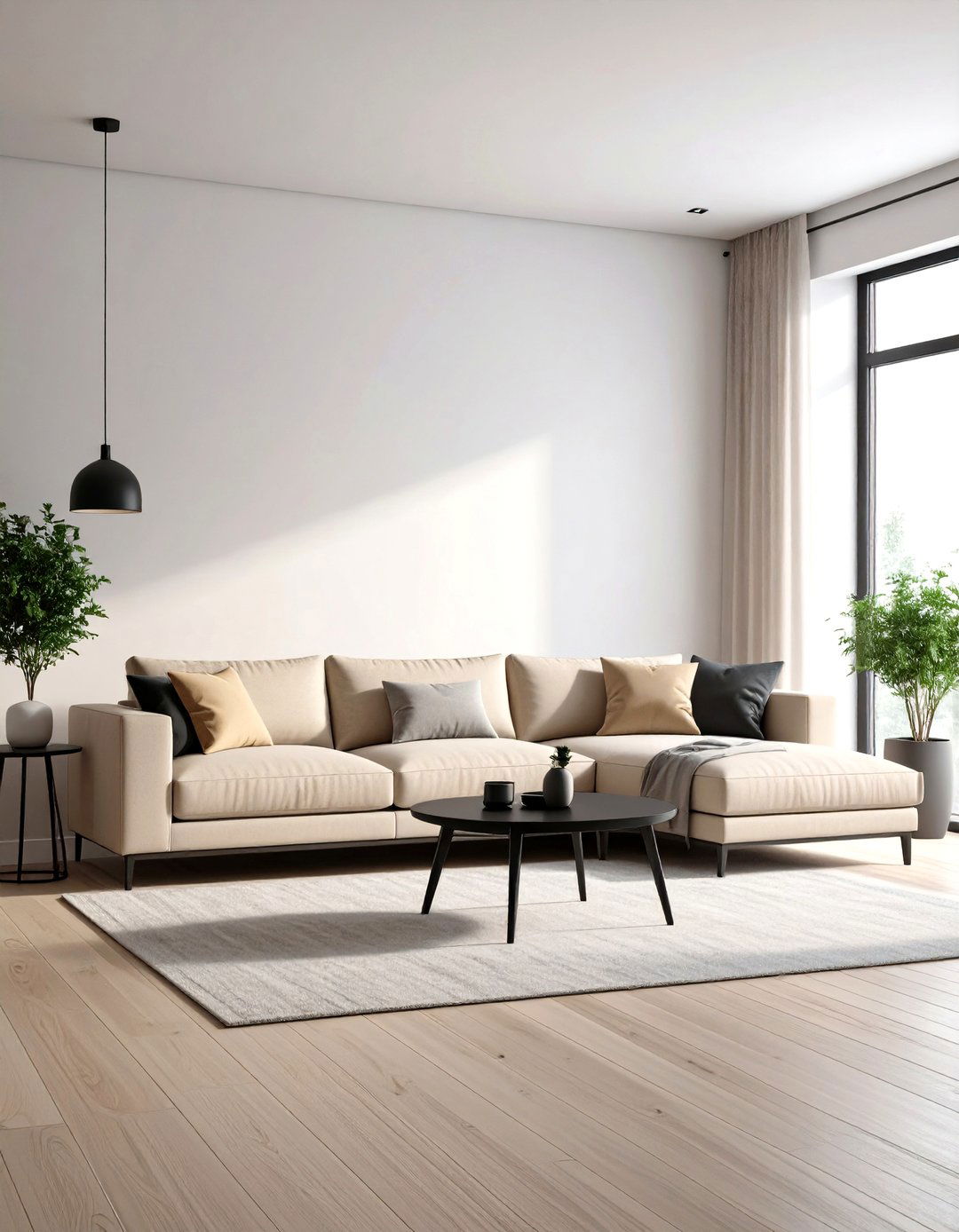
Despite its limited palette, a black-and-beige living room thrives on thoughtful editing. Decluttering surfaces and selecting fewer, higher-quality pieces prevents the scheme from tipping into busy territory and keeps the eye receptive to contrast. Trend analysts predicting a shift away from overly styled “vanilla” looks toward authentic curation underscore the value of negative space and deliberate choices. Arrange furniture so each item breathes; let a single black armchair counterbalance a beige sectional across the room. This restrained approach amplifies every accent and ensures the overall ambiance remains calm, chic, and enduring.
20. Refresh Easily with Seasonal Swaps
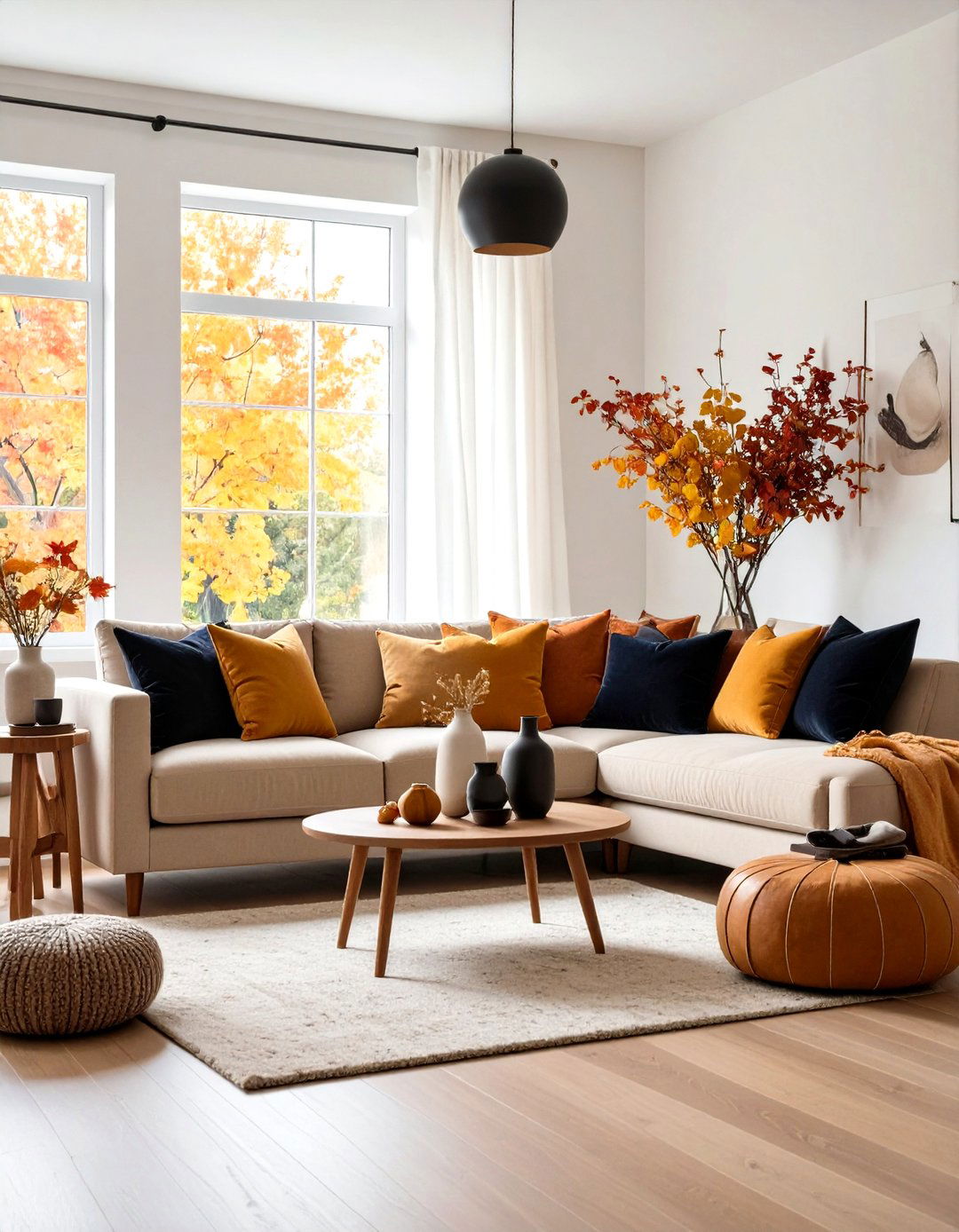
To keep the living room feeling fresh, rely on interchangeable accessories while preserving the black-and-beige core. Beige slipcovers can be exchanged for lightweight linen in summer, while black velvet cushions or candleholders introduce cozy depth in cooler months. Designers who champion neutral palettes emphasize that small edits—new textured pillows, a graphic throw, or ceramic vases—can completely shift mood without repainting walls. Because base hues stay constant, every seasonal update looks cohesive and intentional. This flexible strategy protects budgets, reduces waste, and sustains long-term love for the thoughtfully curated color story.
Conclusion:
Black and beige form a timeless duet that marries elegance with warmth, turning any living room into a haven of confident style. By layering neutral foundations, pinpointing dark contrasts, and weaving in organic textures, metallic glints, and sculptural details, you craft a space that feels both current and personal. Trend reports consistently celebrate the resurgence of rich beiges and strategic black accents, proving that restraint can be powerful. Whether you adopt one idea or many, remember that balance and intentionality are key—choose pieces you love, allow negative space to breathe, and let the interplay of shadow and light tell your unique story.


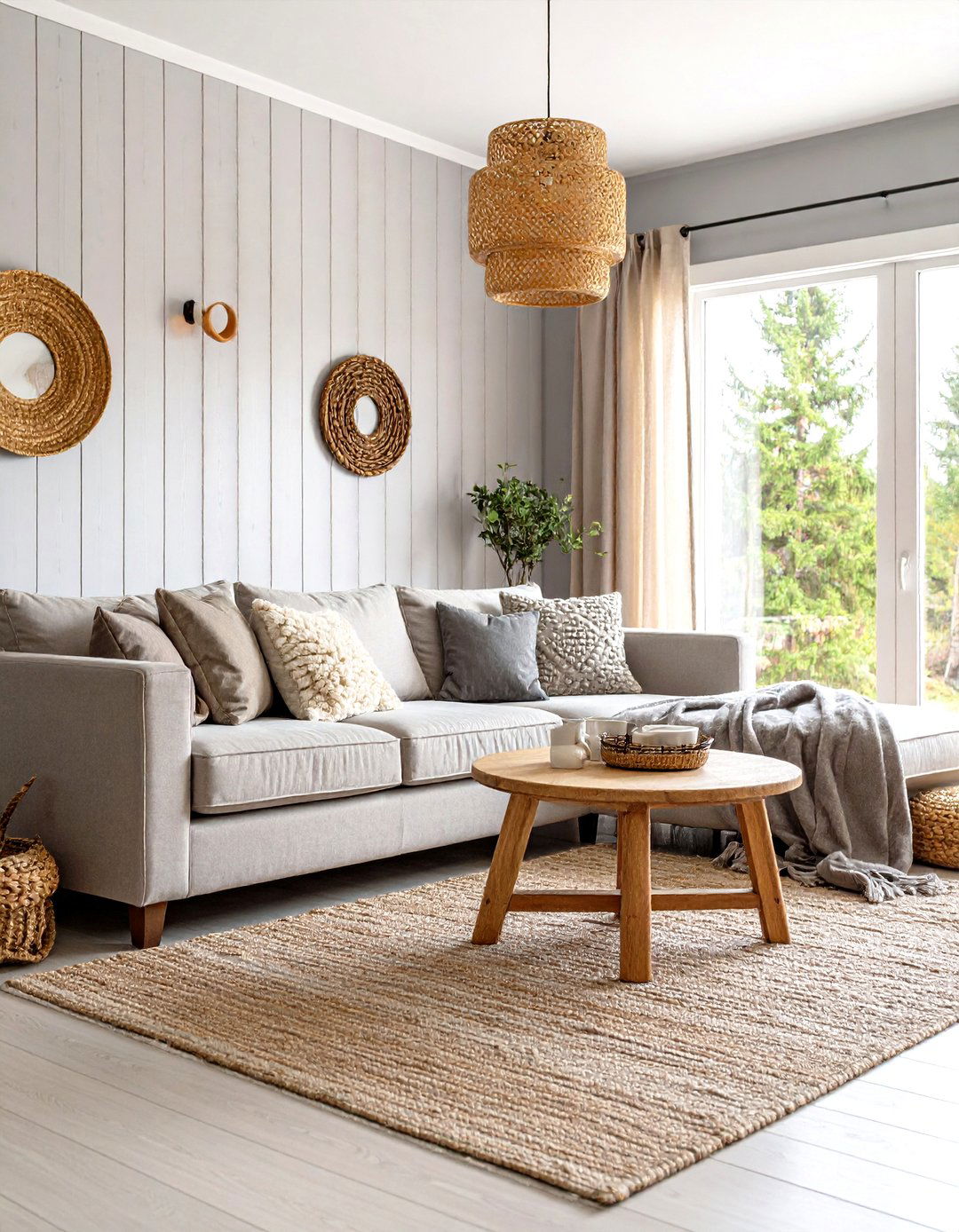
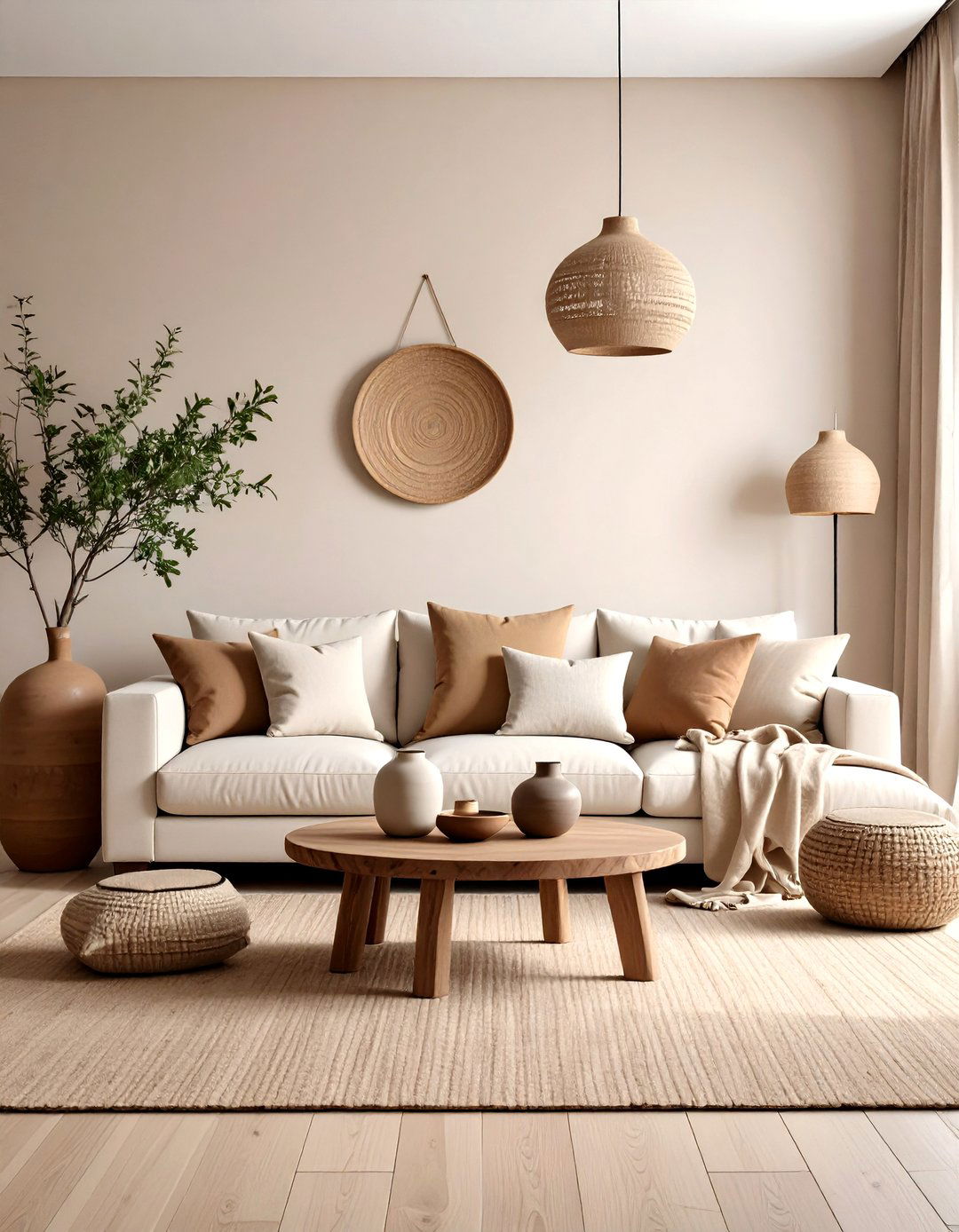


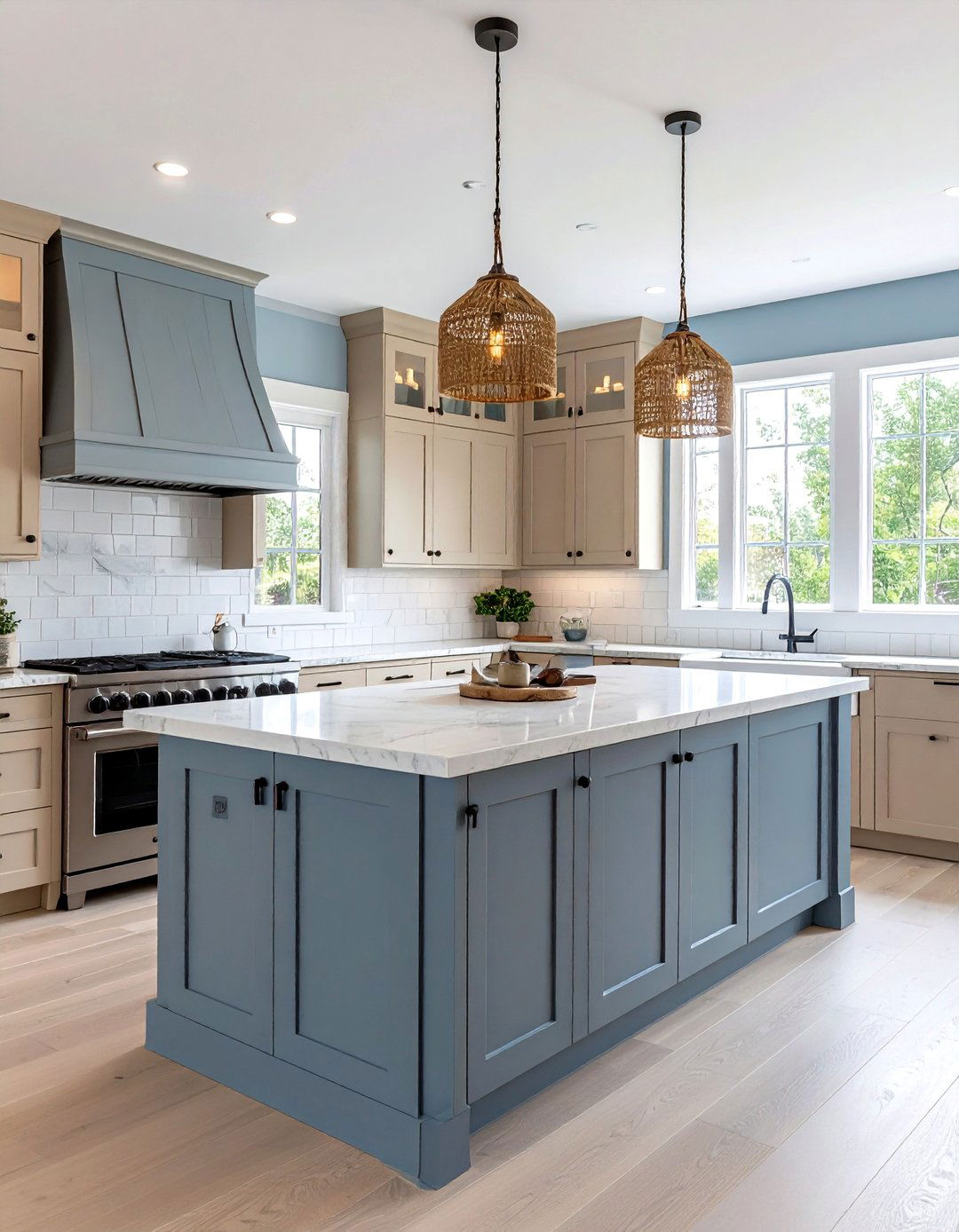
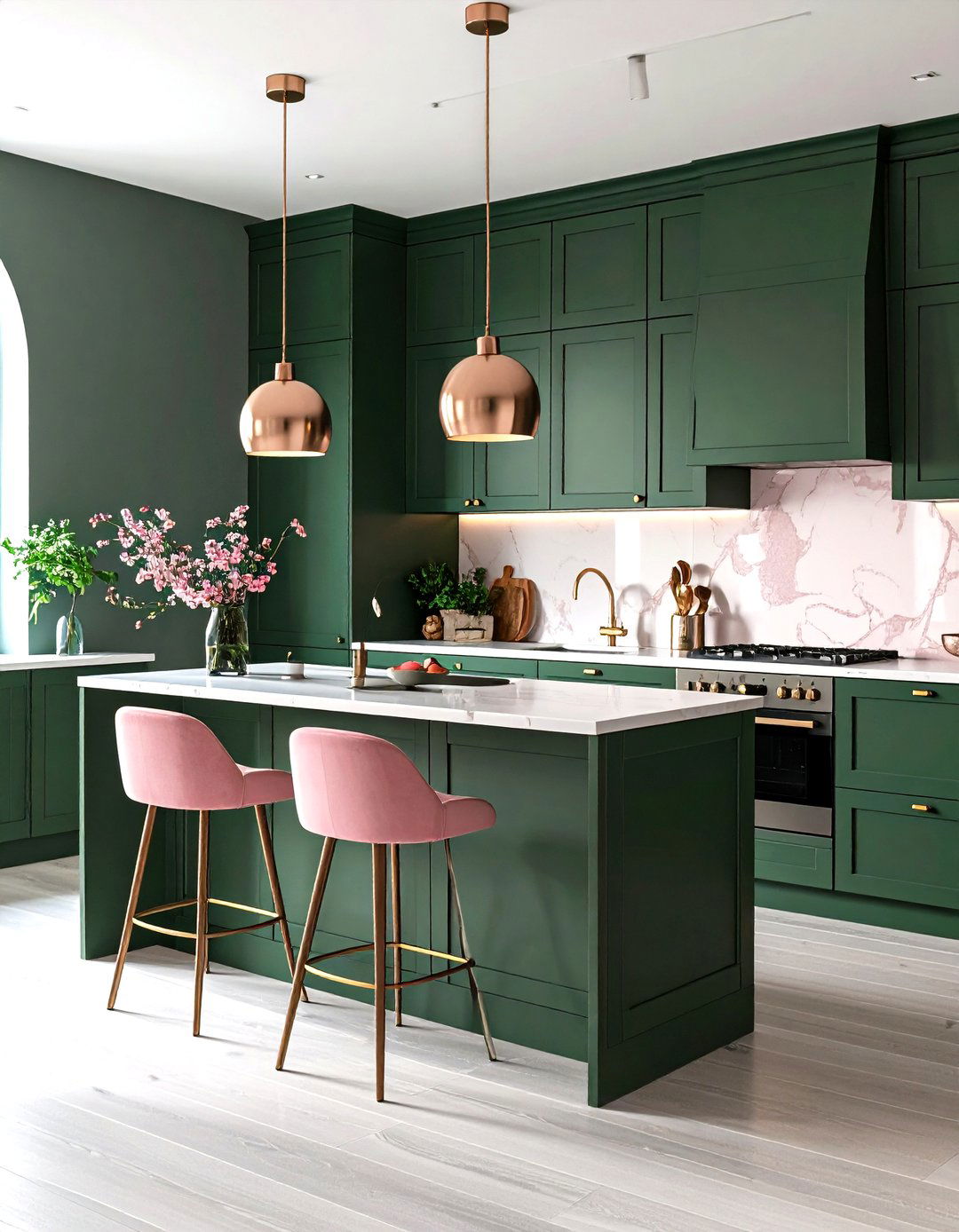
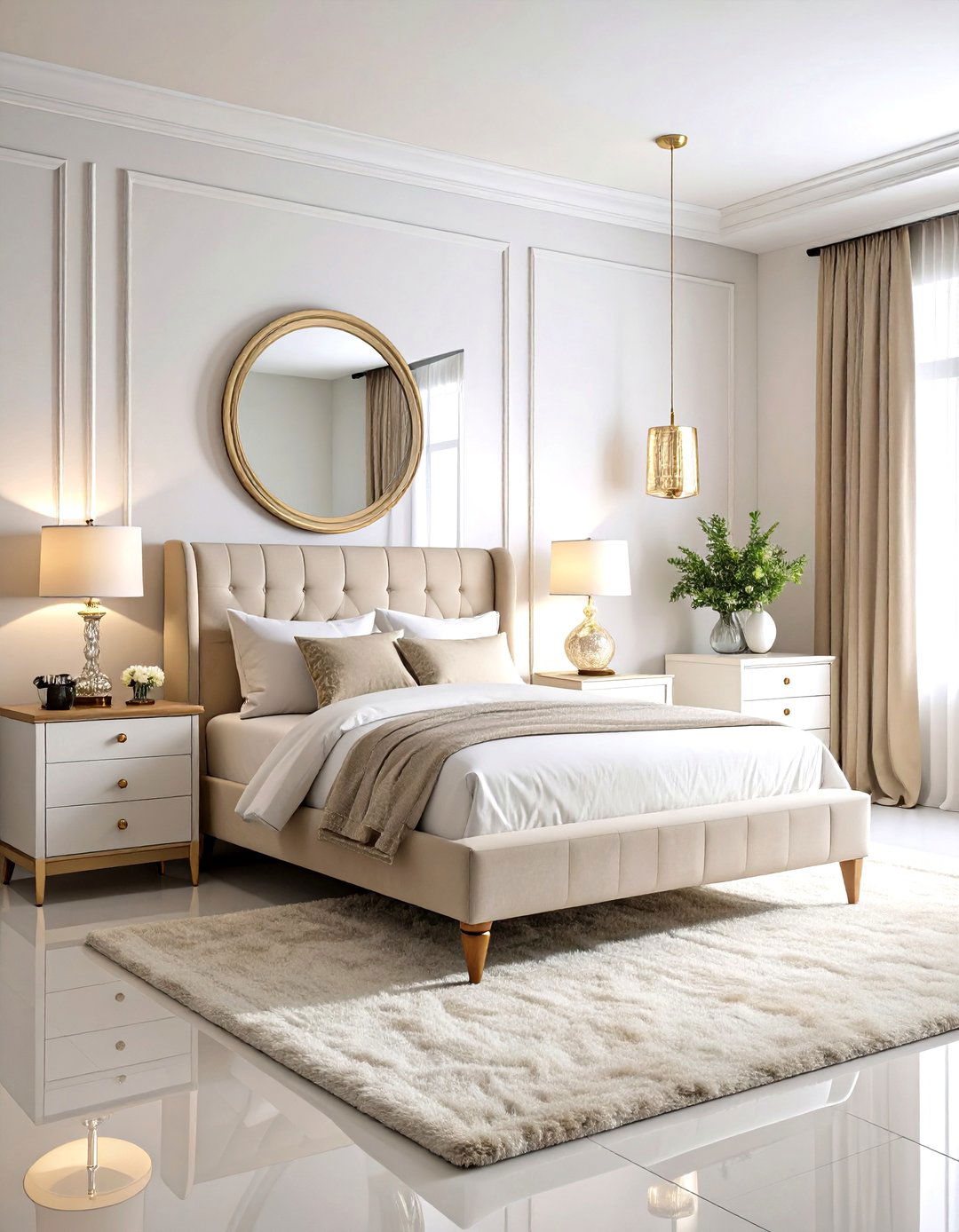

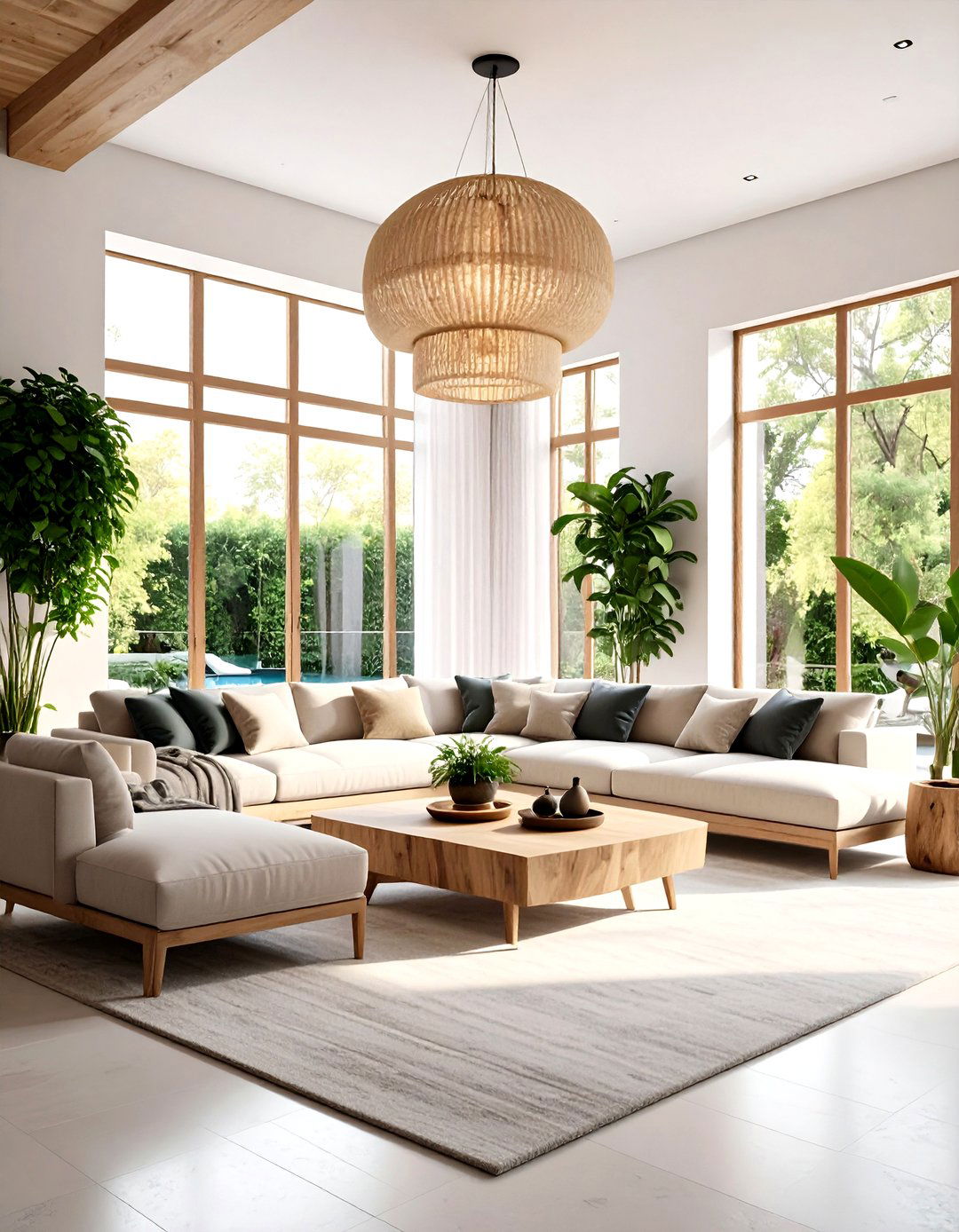
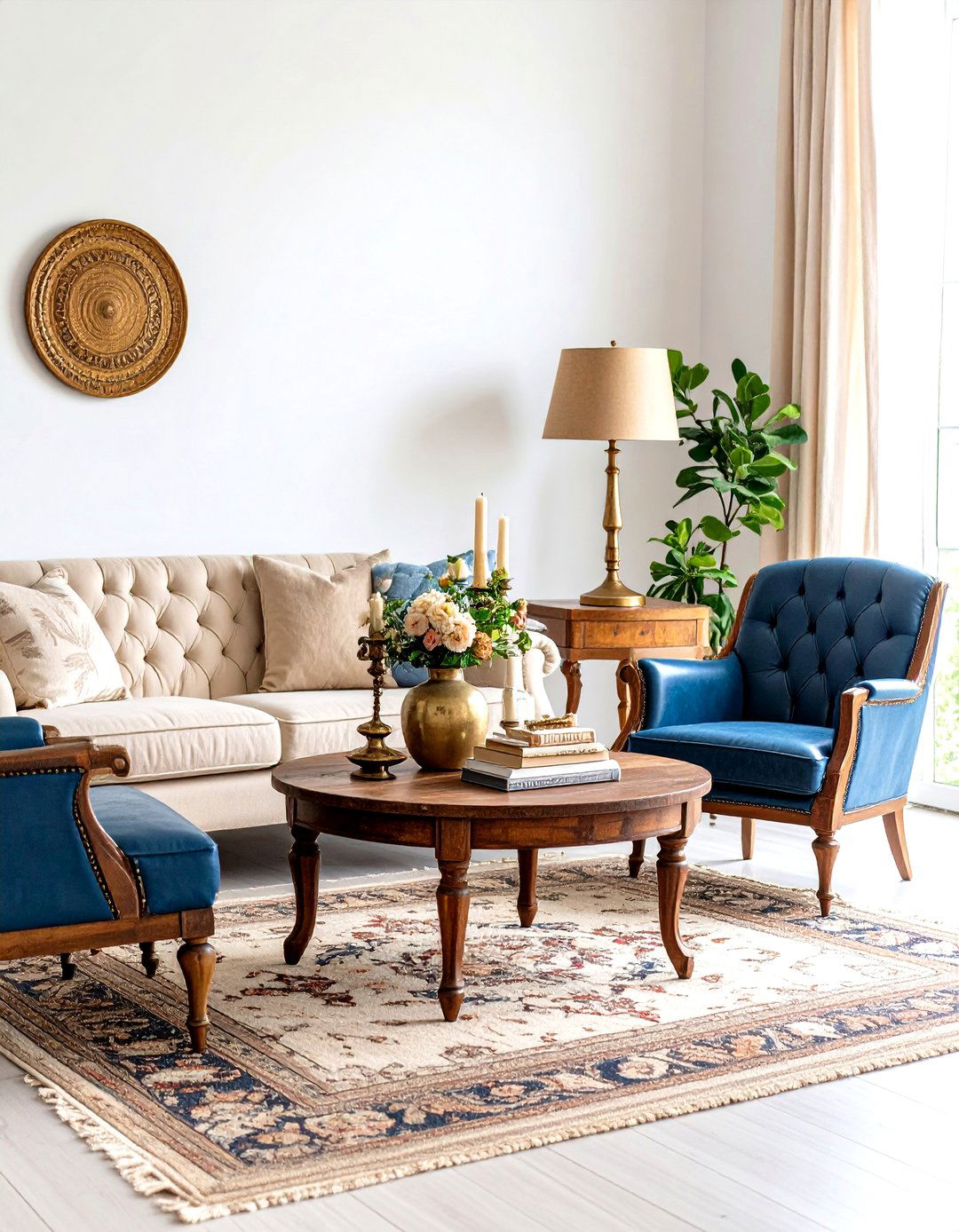
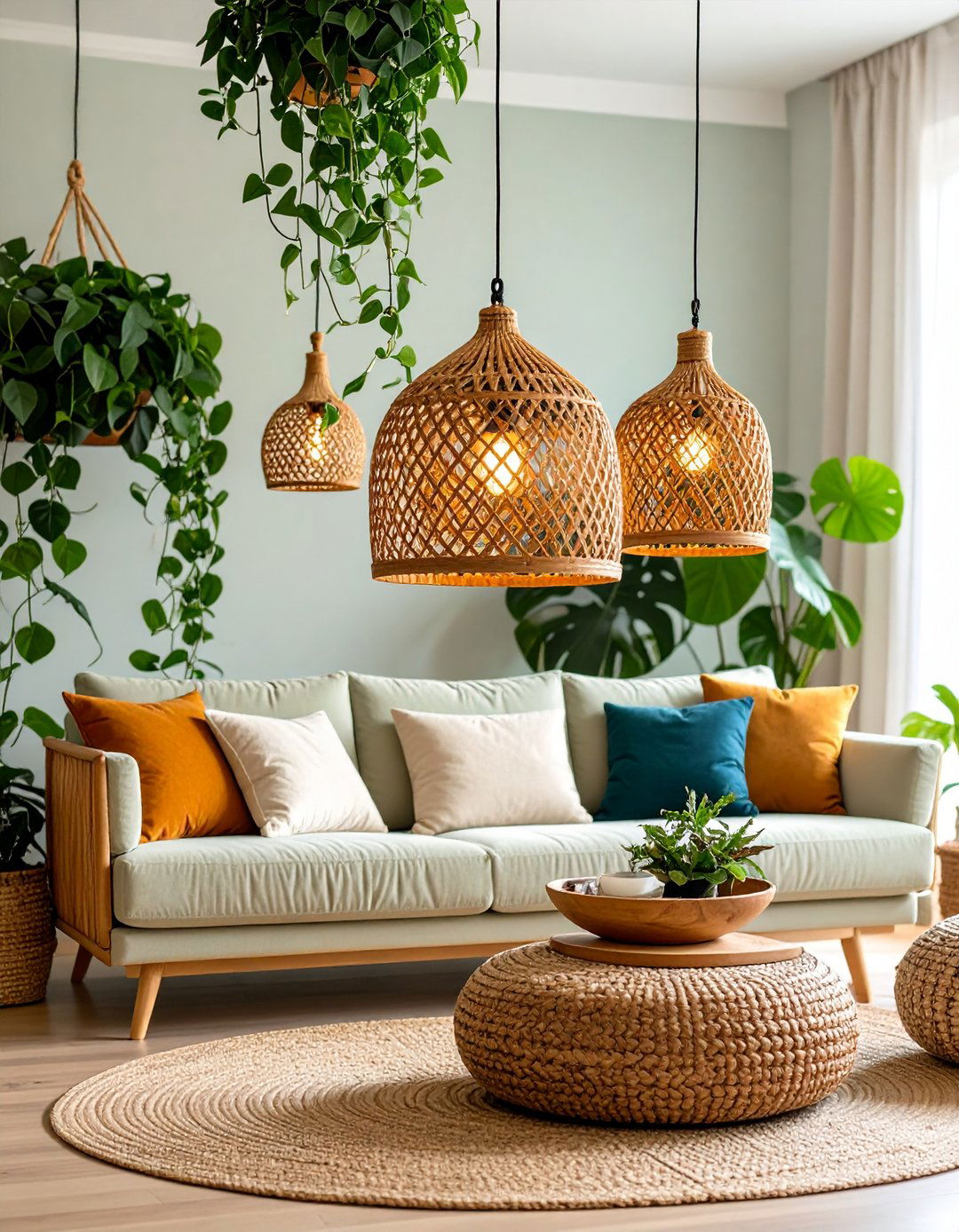
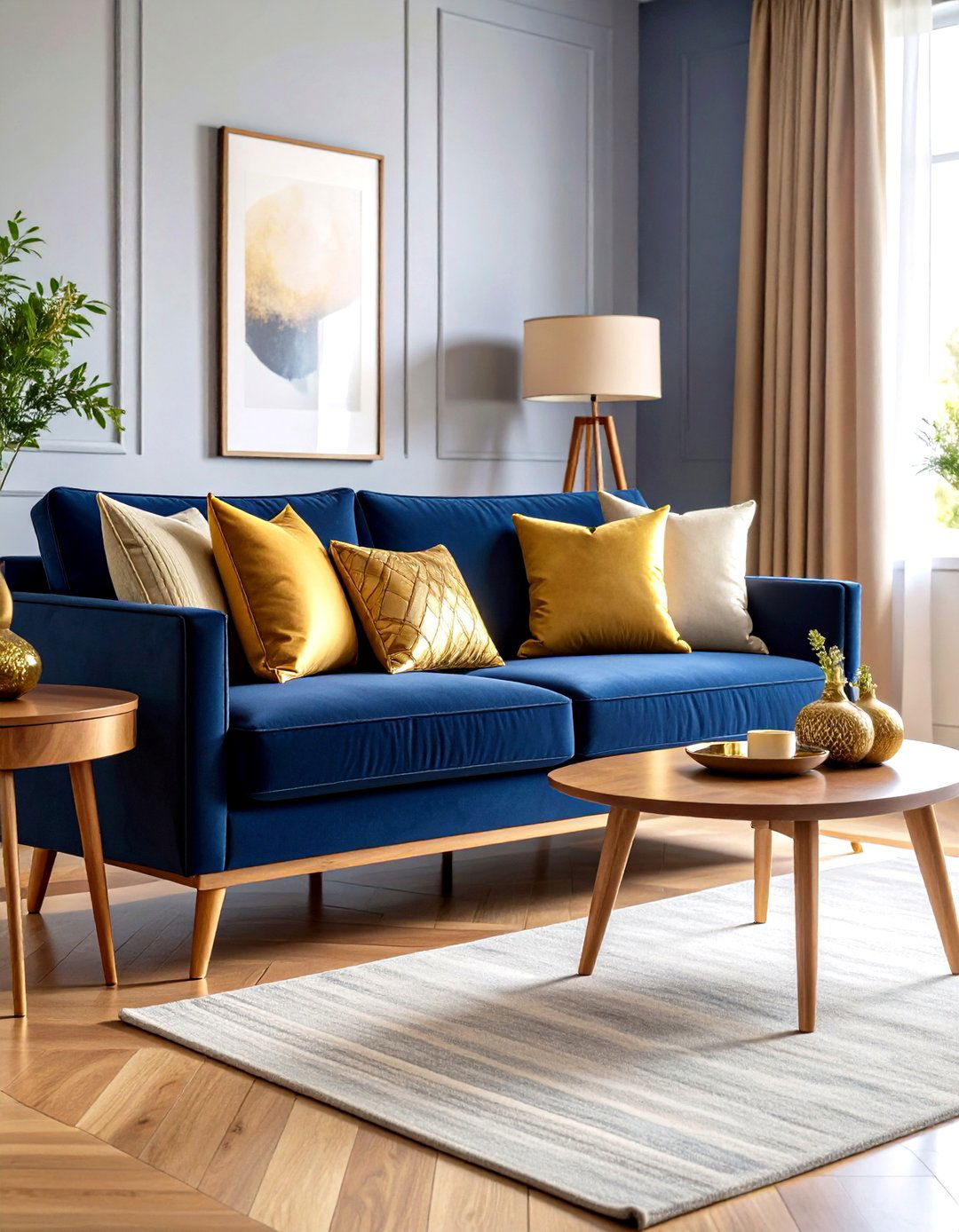
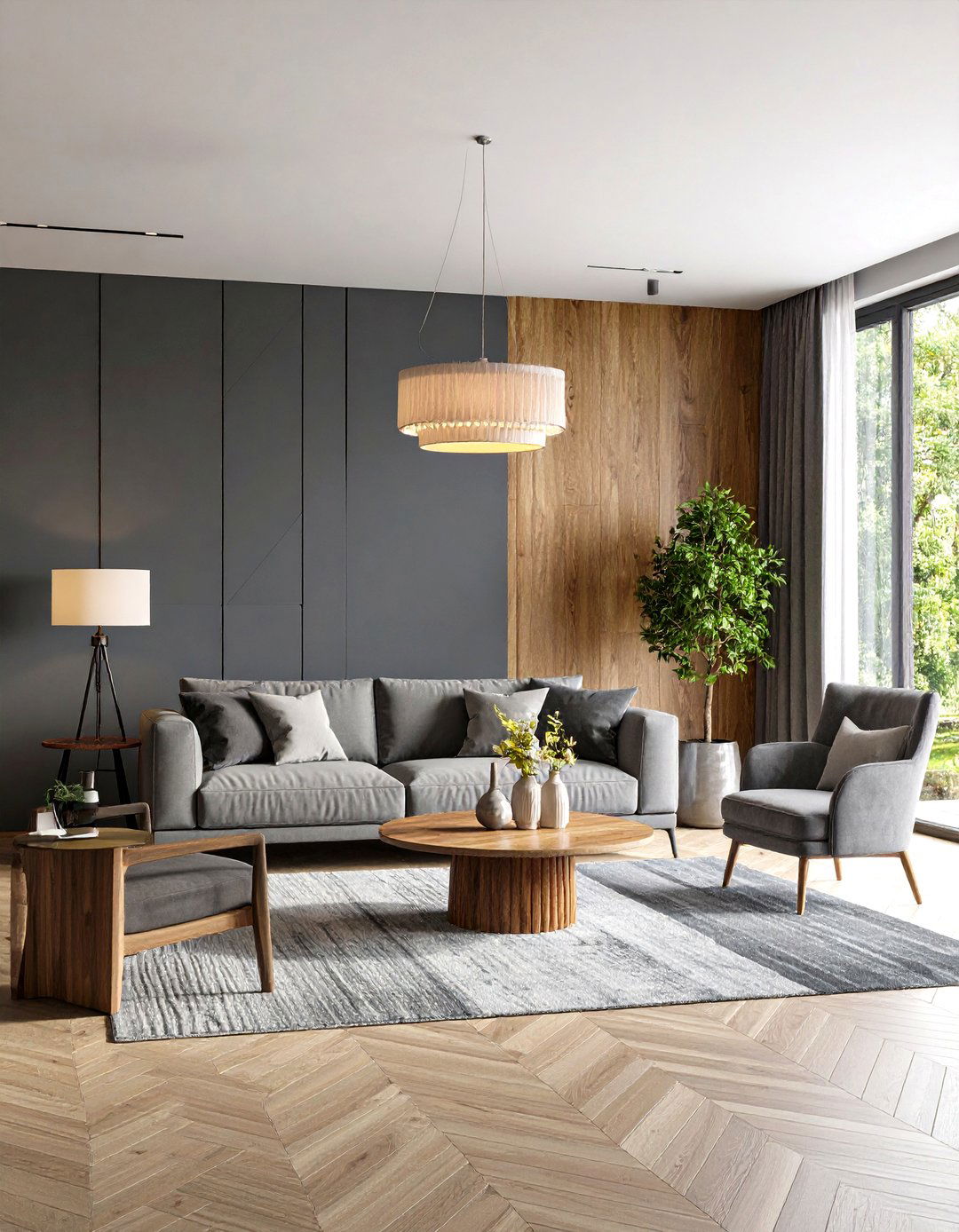

Leave a Reply